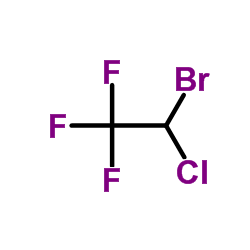Halothane

Halothane structure
|
Common Name | Halothane | ||
|---|---|---|---|---|
| CAS Number | 151-67-7 | Molecular Weight | 197.382 | |
| Density | 1.9±0.1 g/cm3 | Boiling Point | 53.4±8.0 °C at 760 mmHg | |
| Molecular Formula | C2HBrClF3 | Melting Point | N/A | |
| MSDS | Chinese USA | Flash Point | -13.9±18.4 °C | |
| Symbol |



GHS05, GHS07, GHS08 |
Signal Word | Danger | |
|
Neurobehavioral Differences Between Mice Receiving Distinct Neuregulin Variants as Neonates; Impact on Sensitivity to MK-801.
Curr. Mol. Med. 15 , 222-36, (2015) Neuregulin-1 (NRG1) is a well-recognized risk gene for schizophrenia and is often implicated in the neurodevelopmental hypothesis of this illness. Alternative splicing and proteolytic processing of the NRG1 gene produce more than 30 structural variants; howev... |
|
|
MeCP2 Affects Skeletal Muscle Growth and Morphology through Non Cell-Autonomous Mechanisms.
PLoS ONE 10 , e0130183, (2015) Rett syndrome (RTT) is an autism spectrum disorder mainly caused by mutations in the X-linked MECP2 gene and affecting roughly 1 out of 10.000 born girls. Symptoms range in severity and include stereotypical movement, lack of spoken language, seizures, ataxia... |
|
|
Cheminformatics analysis of assertions mined from literature that describe drug-induced liver injury in different species.
Chem. Res. Toxicol. 23 , 171-83, (2010) Drug-induced liver injury is one of the main causes of drug attrition. The ability to predict the liver effects of drug candidates from their chemical structures is critical to help guide experimental drug discovery projects toward safer medicines. In this st... |
|
|
Translating clinical findings into knowledge in drug safety evaluation--drug induced liver injury prediction system (DILIps).
J. Sci. Ind. Res. 65(10) , 808, (2006) Drug-induced liver injury (DILI) is a significant concern in drug development due to the poor concordance between preclinical and clinical findings of liver toxicity. We hypothesized that the DILI types (hepatotoxic side effects) seen in the clinic can be tra... |
|
|
Air to lung partition coefficients for volatile organic compounds and blood to lung partition coefficients for volatile organic compounds and drugs.
Eur. J. Med. Chem. 43 , 478-85, (2008) Values of in vitro gas to lung partition coefficients, K(lung), of VOCs have been collected from the literature. For 44 VOCs, application of the Abraham solvation equation to log K(lung) yielded a correlation with R(2)=0.968 and S.D.=0.25 log units. Combinati... |
|
|
Quantitative structure-activity relationship and complex network approach to monoamine oxidase A and B inhibitors.
J. Med. Chem. 51 , 6740-51, (2008) The work provides a new model for the prediction of the MAO-A and -B inhibitor activity by the use of combined complex networks and QSAR methodologies. On the basis of the obtained model, we prepared and assayed 33 coumarin derivatives, and the theoretical pr... |
|
|
Protective role of the capsule and impact of serotype 4 switching on Streptococcus mitis.
Infect. Immun. 82(9) , 3790-801, (2014) The polysaccharide capsule surrounding Streptococcus pneumoniae is essential for virulence. Recently, Streptococcus mitis, a human commensal and a close relative of S. pneumoniae, was also shown to have a capsule. In this study, the S. mitis type strain switc... |
|
|
Human neural stem cell intracerebral grafts show spontaneous early neuronal differentiation after several weeks.
Biomaterials 44 , 143-54, (2015) Human neural stem cells (hNSCs) hold great promise for the treatment of neurological diseases. Considerable progress has been made to induce neural differentiation in the cell culture in vitro and upon transplantation in vivo [2] in order to explore restorati... |
|
|
Propofol post-conditioning protects the blood brain barrier by decreasing matrix metalloproteinase-9 and aquaporin-4 expression and improves the neurobehavioral outcome in a rat model of focal cerebral ischemia-reperfusion injury.
Mol. Med. Report. 12 , 2049-55, (2015) Propofol, an intravenous anesthetic, inhibits neuronal apoptosis induced by ischemic stroke, protects the brain from ischemia/reperfusion injury and improves neuronal function. However, whether propofol is able to protect the blood brain barrier (BBB) and the... |
|
|
Aberrant NMDA-dependent LTD after perinatal ethanol exposure in young adult rat hippocampus.
Hippocampus 25 , 912-23, (2015) Irreversible cognitive deficits induced by ethanol exposure during fetal life have been ascribed to a lower NMDA-dependent synaptic long-term potentiation (LTP) in the hippocampus. Whether NMDA-dependent long-term depression (LTD) may also play a critical rol... |